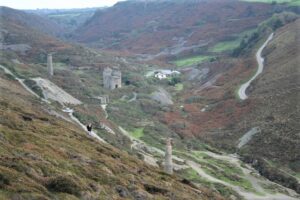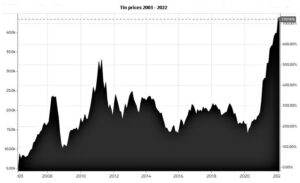Ertach Kernow - The birth of Cornish tin mining
The birth of Cornish tin mining is something to think about as Cornwall’s national day and the celebration of St Piran, the patron saint of tin-miners, is fast approaching. It seems opportune to talk about the metal that was the early source of Cornish wealth, as well as perhaps still to contribute to Cornwall’s future. Although St Piran has been credited with discovering tin we know this is just a legend and that tin was being extracted and used over 2,000 years previous to him being washed up on our shores.
Following on from the late Stone Age, the Neolithic, there was a period which is less spoken about, known as the Copper Age. Various part of the world developed at different times relating to the move from hunter gatherers to farming and the same happened with the use of metals. Copper was too soft for long term tool use and after the discovery of the addition of 10% - 15% tin the resulting alloy bronze was much better suited for hard working tools and weapons. The first European Bronze Age civilization grew up on islands off Greece and was known as the Cycladic civilization around 3,200 BCE. This was followed soon after by the Minoans of Crete and then the Mycenaeans about 1600 BCE on the Greek mainland. It was around 1900 BCE that Britain became part of the Bronze Age and archaeology has shown that Cornwall was at the forefront of this new era contributing to the evolution of the ancient Britons and parts of Europe from the Copper Age. Bronze a harder metal would continue to be used well into the early part of the Iron Age.
Tin ingots found on an ancient Bronze Age shipwreck off the coast of Israel were shown to have originated in Cornwall and dated to about 1000 BCE. Trade with the Levant (eastern Mediterranean) by Phoenician traders from cities such as Tyre and Sidon was recorded in historic text by a number of writers, including the book of Ezekiel in the bible. Although Cornwall was not necessarily always mentioned by name, the fact that these traders ventured far and wide beyond the ‘Pillars of Hercules’ into the Atlantic Ocean suggests that Cornish minerals would have been a valued commodity in trade.
The Greek writer Diodorus Siculus wrote during the 1st century BCE, albeit in translation. We shall now only say something concerning the island, and the tin that's found there. In form it's triangular, like Sicily; but the sides are unequal. It lies in an oblique line, over against the continent of Europe; so that the promontory called Cantium (Kent) next to the Continent is about a hundred furlongs from the land. Here the sea ebbs and flows, but the other point called Belerium, (Cornwall Point, or the Land's End) is four days sail from the continent…. Also, now we shall speak something of the tin that's dug and gotten there. They that inhabit the British promontory of Belerium (Cornwall), by reason of their converse with merchants, are more civilised and courteous to strangers than the rest are. These are the people that make the tin, which with a great deal of care and labour they dig out of the ground; and that being Rocky, the metal is mixed with some veins of earth, out of which they melt the metal, and then refine it: Then they beat it into four-square pieces like to a dye and carry it to a British isle near at hand, called Ictis.
Other ancient writers wrote of the tin trade, not clearly naming any recognisable place clearly identifiable as Cornwall. However, a scientific paper produced in 2019 explained that by using a combined approach of tin and lead isotopes together with trace elements it is possible to narrow down the potential sources of tin for the first time… With the help of the tin isotope composition and the trace elements of the objects it is further possible to exclude many tin resources from the European continent and, considering the current state of knowledge and the available data, to conclude that Cornish tin mines are the most likely suppliers for the 13th – 12th BCE century tin ingots found off Israel. It has been suggested that the tin came from the St Agnes region.
So, what was happening here in Cornwall during those ancient times that made Cornish tin so available for export. At that time the majority of tin would have been obtained through tin panning in streams and rivers to separate the tin from lighter sands, as well as from eroded outcrops close to the surface. More than sufficient tin must have been found to meet local needs for bronze production here in Cornwall and beyond into what would become Great Britain. By at least 3,000 years ago tin was being exported considerable distances by sea. The area around Pentewan was thought to have been mined for tin at an early stage with the discovery of a wood lined shaft some ten feet below the level of the 18th century ground surface. Discovery of tin nodules at Bronze Age settlement sites such as Trevisker, St Eval and subsequent radiocarbon dating has suggested occupation and tin production there within a period 1700-1300 BCE. Protection of tin deposits it has been suggested were constructed through defensive ditches enclosing areas rich in tin deposits at Carn Brea, and also perhaps construction of the Bolster Bank protecting rich cassiterite deposits at St Agnes Beacon.
The coming of the Romans saw some tin extraction taking place from the second century, evidenced by finding Roman coins at early workings and perhaps their milestones in attempts at road construction. The Roman tin bowl found at Treloy in old tin stream workings is evidence that tin was being extracted there. The Romans had fully exploited and exhausted tin workings in Spain and with high demand, especially for the production of pewter objects, Cornwall was somewhere where tin remained available. Pewter is an alloy that was harder than tin, but still easily cast and historically would have been made up of primarily tin, with the addition of lead and copper.
Following the Roman departure in 410 life in Cornwall would have continued much as it had before. Trade with the continent, as shown by archaeological excavations at the Tintagel Castle site, continued. Huge numbers of pottery sherds from amphora were found there. Amphora were used for transporting olive oil, wine and other high value products illustrating the types of imports. No doubt tin was part of the valuable export trade taking place during the 6th century. It was around about this time, during the Age of Saints, that St Piran arrived in Cornwall further down the coast around Perranporth.
There is scant evidence for tin extraction during this period, but evidence of trade suggest that it continued. What else of great value would there have been at that time to export? An ecclesiastical community existed at Trewhiddle and an Anglo-Saxon treasure hoard with coins dated between 757 to 901 was found there in old 9th century tin stream workings. Other finds which can be dated have been discovered in the context of the early medieval period on the Goss Moor and at Chun Castle.
It may be that St Piran didn’t actually discover tin and tin smelting, but perhaps he was connected to exploiting the rich tin deposits around Perranporth in some way, leading to the legend. The later heydays of Cornish tin mining from the Norman Conquest onwards will need to wait for future articles as we move on over a thousand years to the present day. As we remember the past, Cornwall must also look to the future with the planned reopening of South Crofty. Although mining may not reach past dizzying heights where some parts of Cornwall became the richest areas of land in the world, the future for Cornish tin looks much brighter. Tin prices have reached record levels this year peaking in excess of US$44,000 per metric ton on the wholesale tin market. Similar news would have brought joy to Cornish mine owners some two hundred years ago. This metal has fluctuated wildly in price since the 1850’s, leading to boom and bust in Cornish mining industry, with repercussions on Cornwall’s economy as a whole. The price of tin per metric ton in February 1960 was just US$2100 per ton (value today US$19,950) so there has been a dramatic rise in value. With other world sources considering restricting export, such as Indonesia from 2024, and a combination of current high demand and low stockpiles the resurgence of Cornwall as a tin producer through South Crofty’s reopening look positive.
Cornwall must be thankful for its still abundant natural resources and ensure future wealth created remains in Cornwall by producing jobs and boosting the Cornish economy. During King John’s reign Cornish poet Michael Blaunpayn also known as Michael of Cornwall answered a critic of Cornwall with the final poetic line ‘No sea so full of fish, of tin no shore’. Obviously proud to be a Cornishman pointing out the sources for Cornwall’s wealth. Today in In Harry Glasson’s song, Harry’s song for Cornwall, the final lines of the chorus lay out the occupations that have been and continue to be important to Cornwall. With the reopening of South Crofty, yes the miners will mine again.
‘Let's hear it for the farmers and for the fishermen
Let's hear it for the miners who we hope will mine again’












![[87] Voice - Ertach Kernow -23.02.22A The Birth of Tin Mining [S] Ertach Kernow - The Birth of Tin Mining](https://www.cornwallheritage.com/wp-content/uploads/2022/03/87-Voice-Ertach-Kernow-23.02.22A-The-Birth-of-Tin-Mining-S-229x300.jpg)
![[87] Voice - Ertach Kernow -23.02.22B The Birth of Tin Mining [S] Ertach Kernow - The Birth of Tin Mining](https://www.cornwallheritage.com/wp-content/uploads/2022/03/87-Voice-Ertach-Kernow-23.02.22B-The-Birth-of-Tin-Mining-S-226x300.jpg)
![[87] Ertach Kernow Heritage Column - 23rd February 2022 - Cornish Books and Authors Ertach Kernow Heritage Column - 23rd February 2022 - Cornish Books and Authors](https://www.cornwallheritage.com/wp-content/uploads/2022/02/87-Ertach-Kernow-Heritage-Column-23rd-February-2022-Cornish-Books-and-Authors-300x300.jpg)